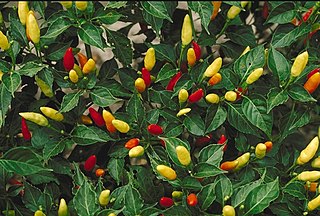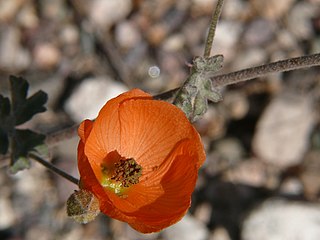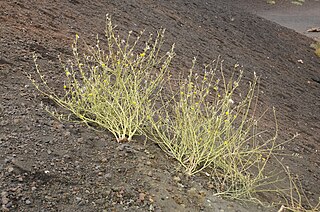
Thyme is the herb of some members of the genus Thymus of aromatic perennial evergreen herbs in the mint family Lamiaceae. Thymes are relatives of the oregano genus Origanum, with both plants being mostly indigenous to the Mediterranean region. Thymes have culinary, medicinal, and ornamental uses, and the species most commonly cultivated and used for culinary purposes is Thymus vulgaris.

A shrub is a small-to-medium-sized perennial woody plant. Unlike herbaceous plants, shrubs have persistent woody stems above the ground. Shrubs can be either deciduous or evergreen. They are distinguished from trees by their multiple stems and shorter height, less than 6–10 m (20–33 ft) tall. Small shrubs, less than 2 m (6.6 ft) tall are sometimes termed as subshrubs. Many botanical groups have species that are shrubs, and others that are trees and herbaceous plants instead.

Aster is a genus of perennial flowering plants in the family Asteraceae. Its circumscription has been narrowed, and it now encompasses around 170 species, all but one of which are restricted to Eurasia; many species formerly in Aster are now in other genera of the tribe Astereae. Aster amellus is the type species of the genus and the family Asteraceae.

Herbaceous plants are vascular plants that have no persistent woody stems above ground. This broad category of plants includes many perennials, and nearly all annuals and biennials.

A perennial plant or simply perennial is a plant that lives more than two years. The term is often used to differentiate a plant from shorter-lived annuals and biennials. The term is also widely used to distinguish plants with little or no woody growth from trees and shrubs, which are also technically perennials.

Corydalis is a genus of about 470 species of annual and perennial herbaceous plants in the family Papaveraceae, native to the temperate Northern Hemisphere and the high mountains of tropical eastern Africa. They are most diverse in China and the Himalayas, with at least 357 species in China.

Capsicum frutescens is a wild chili pepper having genetic proximity to the cultivated pepper Capsicum chinense native to Central and South America. Pepper cultivars of C. frutescens can be annual or short-lived perennial plants. Flowers are white with a greenish white or greenish yellow corolla, and are either insect- or self-pollinated. The plants' berries typically grow erect; ellipsoid-conical to lanceoloid shaped. They are usually very small and pungent, growing 10–20 millimetres (0.39–0.79 in) long and 3–7 millimetres (0.12–0.28 in) in diameter. Fruit typically grows a pale yellow and matures to a bright red, but can also be other colors. C. frutescens has a smaller variety of shapes compared to other Capsicum species. C. frutescens has been bred to produce ornamental strains because of its large quantities of erect peppers growing in colorful ripening patterns.

Cistanche is a worldwide genus of holoparasitic desert plants in the family Orobanchaceae. They lack chlorophyll and obtain nutrients and water from the host plants whose roots they parasitize.

Chondrilla juncea is a species of flowering plant in the family Asteraceae known by a number of common names, including rush skeletonweed, gum succory, devil's grass, and nakedweed. The plant is native to Europe, Asia, and North Africa, but it is known throughout most temperate regions of the world as an introduced species which is usually considered a noxious weed.

Kunzea ambigua, commonly known as white kunzea, poverty bush or tick bush, is a plant in the myrtle family, Myrtaceae and is found mainly on sandstone soils in eastern Australia. Growing up to 5 m (16 ft) high and wide, it bears small white flowers in spring. Used in native gardening, it attracts native insects. It is also used in amenities planting and sand dune stabilization.

Sphaeralcea ambigua, is a species of flowering plant commonly known as desert globemallow or apricot mallow, is a member of the genus Sphaeralcea in the mallow family (Malvaceae).

Castilleja linariifolia is a perennial plant, native to the United States and is the state flower of Wyoming. It has a number of common names including Wyoming Indian paintbrush, narrow-leaved Indian paintbrush, desert paintbrush, Wyoming desert paintbrush, Wyoming paintbrush, linaria-leaved Indian Paintbrush, and Indian paintbrush.

A weed is a plant considered undesirable in a particular situation, "a plant in the wrong place", or a plant growing where it is not wanted. This introduces the concept of humans and their goals in a particular setting. The concept of weeds is particularly significant in agriculture, where the aim is growing crops or pastures of a single species, or a mixture of a few desired species. In such environments, other plant species are considered undesirable and therefore a weed. Besides, some weeds have undesirable characteristics making them a plant pest in most human settings.

Babiana ambigua is a species of plant in the Iridaceae. It is endemic to the Western Cape province of South Africa. It is a geophyte, that appears from an underground corm every year and grows to a hight of 5–8 cm (2.0–3.1 in) or occasonally up to 16 cm (6.3 in). Its leaves are pleated, hairy, lance-shaped, reaching higher than the inflorescence. The fragrant, mirror-symmetric, blue to mauve flowers, consist of six tepals merged into a tube at their base, but with free lobes at the top. The lower lateral tepals have withish markings accentuated by a more intense blue line along their margin. Each flower is supported by two green bracts sometimes with a brownish tip, and the inner bract is divided entirely to its base. There are three anthers crowded to the dorsal side of the perianth and a style divided in three branches on top of a smooth ovary. Flowers can be found from late July at sea level to the end of September at high altitude.

Chondrilla is a genus of flowering plants in the family Asteraceae. They are native to Eurasia, and certain taxa are known as introduced species outside their native range. The best known of these is rush skeletonweed, a noxious weed established in Africa, Australia, and the Americas.

Ilex ambigua is a species of flowering plant in the holly family known by the common names Carolina holly and sand holly. It is native to the southeastern and south-central United States, along the coastal plain from North Carolina to Texas, inland as far as Oklahoma, Arkansas, and Tennessee.
Sagittaria ambigua, the Kansas arrowhead, is an aquatic plant species native to the central United States. It grows in wet areas, mostly along the shores of ponds and waterways.

Hypericum delphicum is a perennial herb in the St. John's wort family Hypericaceae, section Adenosepalum and the subsection Adenosepalum. It has a diploid number of 16.

Gerbera ambigua is a species of flowering plant in the section Lasiopus of genus Gerbera belonging to the basal Mutisieae tribe within the large Asteraceae family.

















